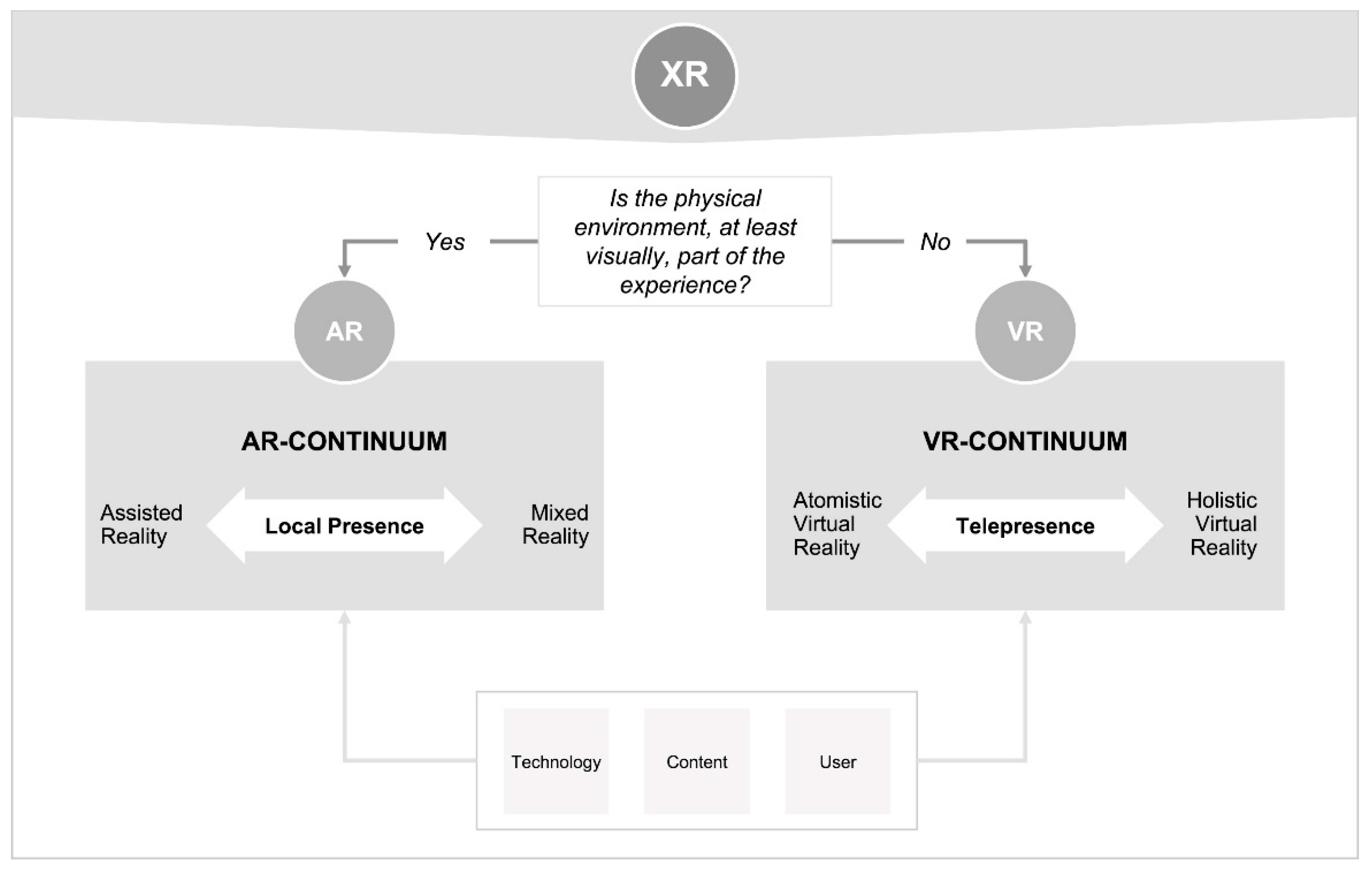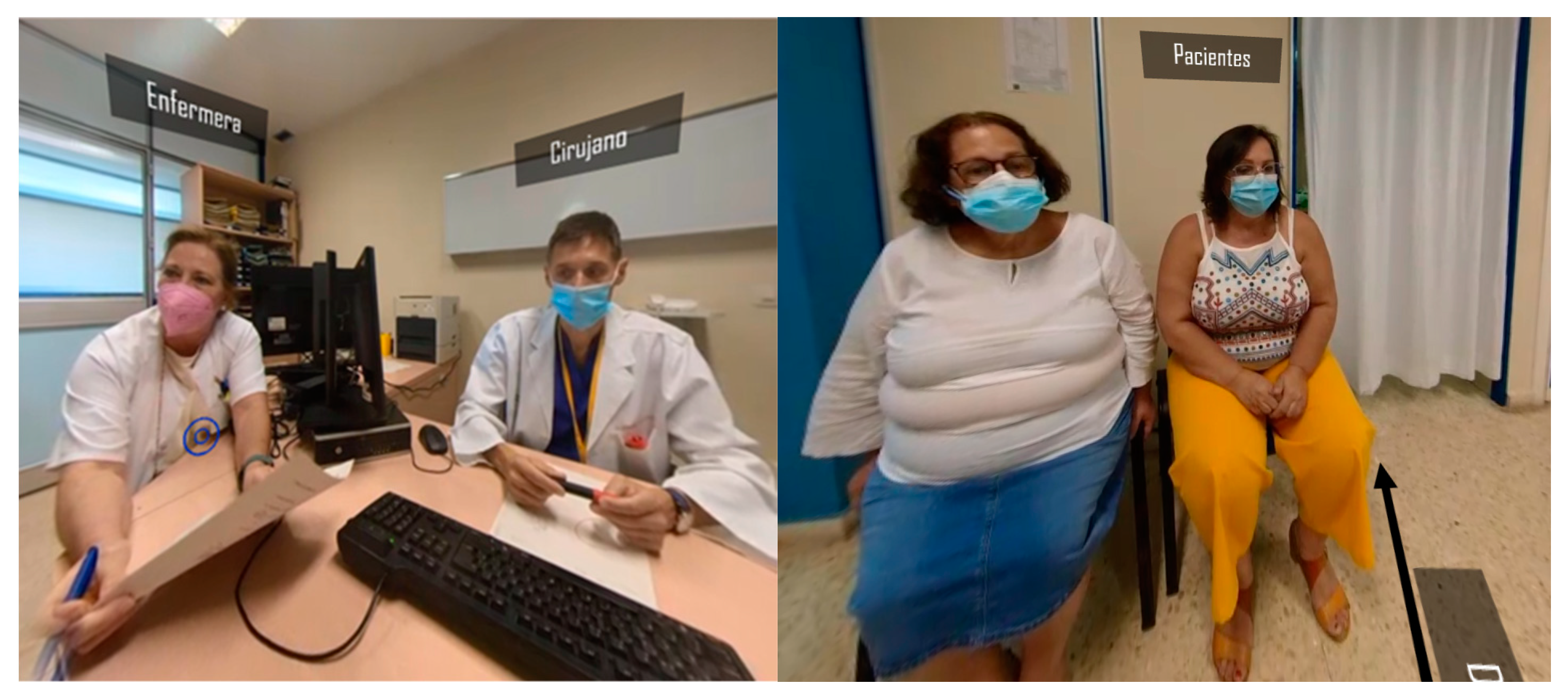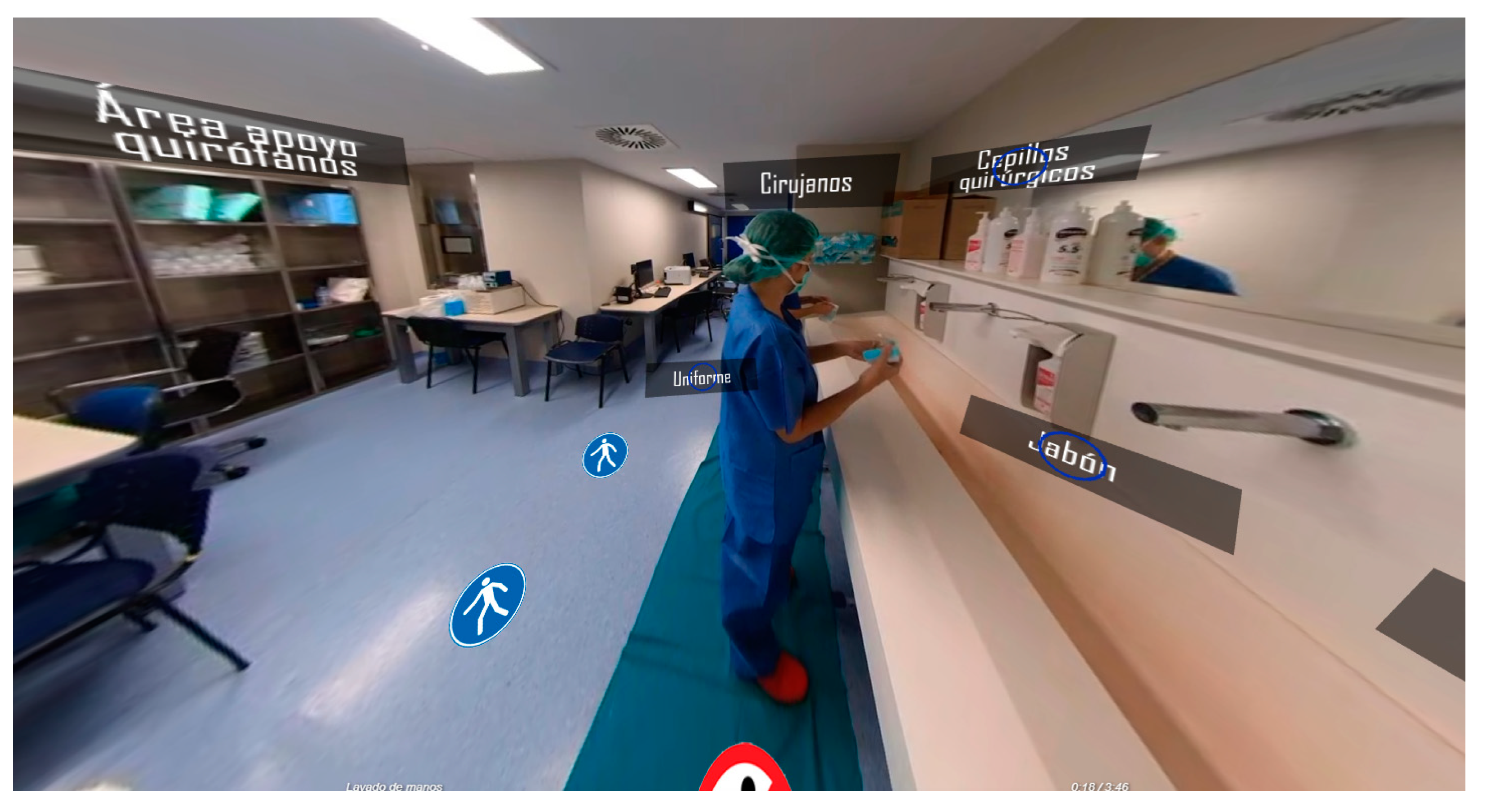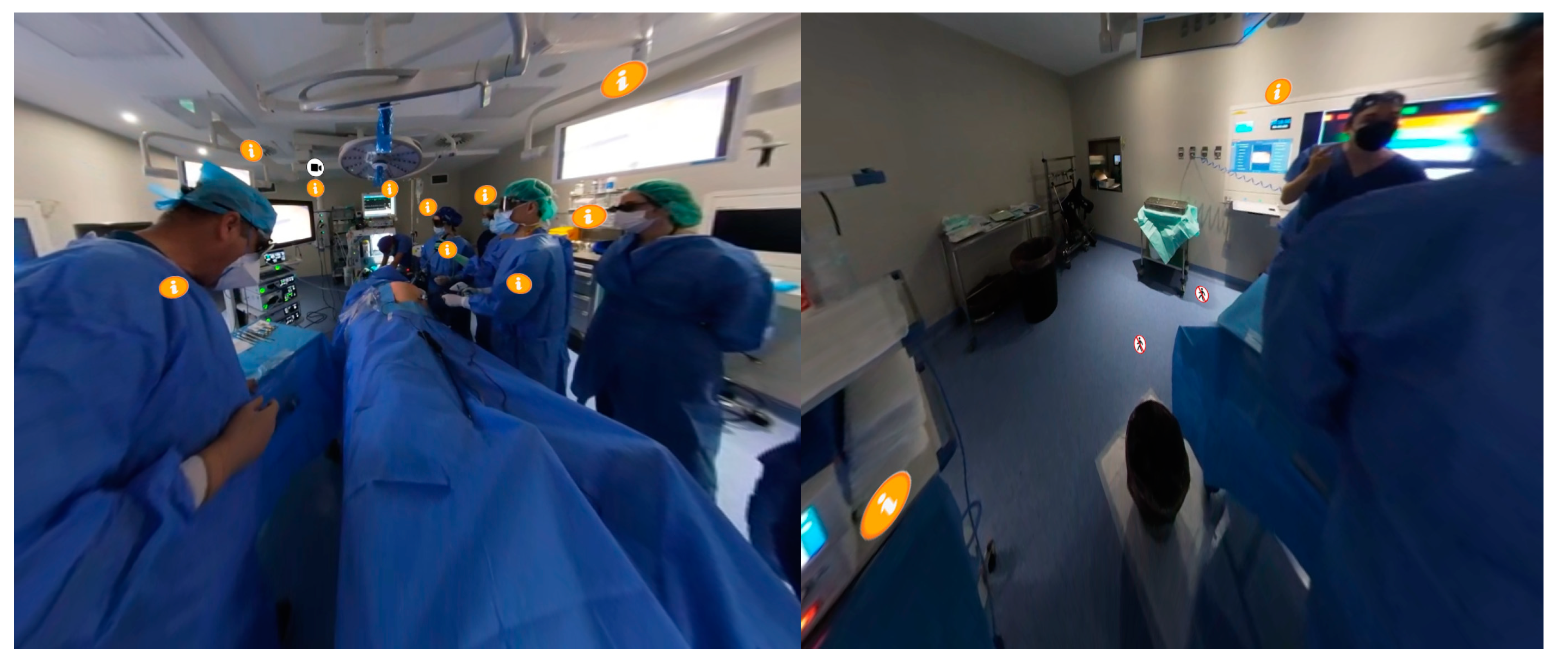Technology-Enhanced Learning in Health Sciences: Improving the Motivation and Performance of Medical Students with Immersive Reality
Abstract
1. Introduction
2. Motivation as a Key Element for Learning and Training
3. Methods
3.1. Objectives
- Examining the degree of motivation perceived through the IMMS that the use of learning objects in IR, designed in a specific way through the use of “hot spots” to offer additional information (computer points, incorporation of texts, incorporation of video clips…). In the experience, immersive reality has been understood as an immersive reality that combines augmented reality (markers) and 360° video (recording of situations in the hospital).
- Analyzing the degree of attention, relevance, trust, and satisfaction analyzed through the IMMS that the use of learning objects in IR, designed in a specific way through the use of “hot spots” to offer additional information (computer points, incorporation of texts, incorporation of video clips...).
- Analyzing whether exposure to objects produced in immersive reality facilitates the acquisition of knowledge.
3.2. Description of the Experience
- Consultation scenario: This object demonstrates how students should interact with patients during consultations, particularly when communicating diagnoses (Figure 2).
- Handwashing scenario: This object guides students through the proper handwashing procedure conducted before surgical interventions (Figure 3).
- Operating room scenario: This object illustrates how students should navigate and conduct themselves within an operating room (Figure 4).
3.3. Instrument
3.4. Sample
4. Results
5. Conclusions
Author Contributions
Funding
Institutional Review Board Statement
Informed Consent Statement
Data Availability Statement
Conflicts of Interest
References
- Cabero, J.; Valencia, R.; Llorente, C. Ecosystem of emerging technologies: Augmented, virtual and mixed reality. Tecnol. Cienc. Y Educ. 2022, 23, 7–22. [Google Scholar] [CrossRef]
- Navarro, F.; Martínez, A.; Martínez, J.M. Realidad Virtual y Realidad Aumentada; Ediciones de la U: Bogotá, Colombia, 2019. [Google Scholar]
- Cabero, J.; Fernández, B.; Marín, V. Dispositivos móviles y realidad aumentada en el aprendizaje del alumnado universitario. RIED Rev. Iberoam. Educ. Distancia. 2017, 20, 167–185. [Google Scholar] [CrossRef]
- Mulders, M.; Buchner, J.; Kerres, M. A Framework for the Use of Immersive Virtual Reality in Learning Environments. Int. J. Emerg. Technol. 2020, 15, 208–224. [Google Scholar] [CrossRef]
- Rauschnabel, P.A.; Felix, R.; Hinsch, C.; Shahab, H.; Alt, F. What is XR? Towards a Framework for Augmented and Virtual Reality. Comput. Hum. Behav. 2022, 133, 107289. [Google Scholar] [CrossRef]
- Ortega-Rodríguez, P.J. De la realidad extendida al metaverso: Una reflexión crítica sobre las aportaciones a la educación. Teor. Educ. 2022, 34, 189–208. [Google Scholar] [CrossRef]
- Roda-Segarra, J.; Mengual-Andrés, S.; Martínez-Roig, R. Using Virtual Reality in Education: A bibliometric analysis. Campus Virtuales 2022, 11, 153–165. [Google Scholar] [CrossRef]
- Di Natale, A.; Repetto, C.; Riva, G.; Villani, D. Imersive virtual reality in K-12 and higher education: A 10-year systematic review of empirical research. Br. J. Educ. Technol. 2020, 51, 2006–2033. [Google Scholar] [CrossRef]
- Tang, Y.M.; Au, K.M.; Lau, H.C.; Ho, G.T.; Wu, C.H. Evaluating the effectiveness of learning design with mixed reality (MR) in higher education. Virtual Real. 2020, 24, 797–807. [Google Scholar] [CrossRef]
- Howard, M.; Gutworth, M.; Jacobs, R. A meta-analysis of virtual reality training programs. Comput. Hum. Behav. 2021, 121, 106808. [Google Scholar] [CrossRef]
- Zhonggen, Y. A meta-analysis of the effect of virtual reality technology use in education. Interact. Learn. Environ. 2021, 23, 67–89. [Google Scholar] [CrossRef]
- Calderón, S.J.; Tumino, M.C.; Bournissen, J.M. Realidad virtual: Impacto en el aprendizaje percibido de estudiantes de Ciencias de la Salud. Tecnol. Cienc. Y Educ. 2020, 16, 65–82. [Google Scholar] [CrossRef]
- Toala-Palma, J.; Arteaga-Mera, J.; Quintana-Loor, J.; Santana-Vergara, M. La Realidad Virtual como herramienta de innovación educativa. Episteme Koinonia. Rev. Electrónica Cienc. Educ. Humanidades Artes Y Bellas Artes 2020, 8, 270–286. [Google Scholar]
- George-Reyes, C.; Ramírez-Montoya, M.; López-Caudana, E.O. Imbricación del Metaverso en la complejidad de la educación 4.0: Aproximación desde un análisis de la literatura [Imbrication of the Metaverse in the complexity of education 4.0: Approach from an analysis of the literature]. Pixel-Bit 2023, 66, 199–237. [Google Scholar] [CrossRef]
- Ogbuanya, T.C.; Ogbonna, N.O. Investigating the Effectiveness of Desktop Virtual Reality for Teaching and Learning of Electrical/Electronics Technology in Universities. Comp. Sch. 2018, 35, 226–248. [Google Scholar] [CrossRef]
- Chang, C.Y.; Sung, H.Y.; Guo, J.L.; Chang, B.Y.; Kuo, F.R. Effects of spherical video-based virtual reality on nursing students’ learning performance in childbirth education training. Interact. Learn. Environ. 2022, 30, 400–416. [Google Scholar] [CrossRef]
- King, S.A.; Dzenga, C.; Burch, T.; Kennedy, K. Teaching partial–interval recording of problem behavior with virtual reality. J. Behav. Educ. 2020, 30, 202–225. [Google Scholar] [CrossRef]
- McGovern, E.; Moreira, G.; Luna, C. An application of virtual reality in education: Can this technology enhance the quality of students’ learning experience? J. Educ. Bus. 2020, 95, 490–496. [Google Scholar] [CrossRef]
- Ausín-Villaverde, V.; Rodríguez-Cano, S.; Delgado-Benito, V.; Bogdan-Toma, R. Evaluación de una APP de realidad aumentada en niños/as con dislexia: Estudio piloto [Evaluation of an augmented reality APP for children with dyslexia: A pilot study]. Pixel-Bit 2023, 66, 85–109. [Google Scholar] [CrossRef]
- Morris, T.H. Experiential learning—A systematic review and revision of Kolb’s model. Interact. Learn. Environ. 2018, 28, 1064–1077. [Google Scholar] [CrossRef]
- Abdulrahman, E.; Al Osman, H. A virtual reality role-playing serious game for experiential learning. Interact. Learn. Environ. 2022, 30, 922–935. [Google Scholar] [CrossRef]
- Fromm, J.; Radianti, J.; Wehking, C.; Stieglitz, S.; Majchrzak, T.A.; vom Brocke, J. More than experience?—On the unique opportunities of virtual reality to afford a holistic experiential learning cycle. Internet High Educ. 2021, 50, 100804. [Google Scholar] [CrossRef]
- Gutiérrez-Castillo, J.J.; Palacios-Rodríguez, A.; Martín-Párraga, L.; Serrano-Hidalgo, M. Development of Digital Teaching Competence: Pilot Experience and Validation through Expert Judgment. Educ. Sci. 2023, 13, 52. [Google Scholar] [CrossRef]
- Brodie, R.J.; Ilic, A.; Juric, B.; Hollebeek, L. The expression of users’ creative potential in virtual and real environments: An exploratory study. Creat. Res. J. 2020, 32, 55–65. [Google Scholar]
- Winkelmann, K.; Keeney-Kennicutt, W.; Fowler, D.; Lazo Macik, M.; Perez Guarda, P.; Joan Ahlborn, C. Learning gains and attitudes of students performing chemistry experiments in an immersive virtual world. Interact. Learn. Environ. 2020, 28, 620–634. [Google Scholar] [CrossRef]
- Sun, C.; Hu, W.; Xu, D. Navigation modes, operation methods, observation scales and background options in UI design for high learning performance in VR-based architectural. J. Comput. Des. Eng. 2019, 6, 180–195. [Google Scholar] [CrossRef]
- Alpizar, D.; Adesope, O.O.; Wong, R.M. A meta-analysis of signaling principle in multimedia learning environments. Educ. Technol. Res. Dev. 2020, 68, 2095–2119. [Google Scholar] [CrossRef]
- Bautista, L.; Maradei, F.; Pedraza, G. Strategies to reduce visual attention changes while learning and training in extended reality environments. Int. J. Interact. Des. Manuf. 2023, 17, 17–43. [Google Scholar] [CrossRef]
- Alfalah, S.F.; Falah, J.F.; Alfalah, T.; Elfalah, M.; Muhaidat, N.; Falah, O. A comparative study between a virtual reality heart anatomy system and traditional medical teaching modalities. Virtual Real. 2019, 23, 229–234. [Google Scholar] [CrossRef]
- Kukulska-Hulme, A.; Bossu, C.; Charitonos, K. Innovating Pedagogy 2021. In Exploring New Forms of Teaching, Learning and Assessment, to Guide Educators and Policy Makers; The Open University: Keynes, UK, 2021. [Google Scholar]
- Saab, M.; Hegarty, J.; Murphy, D.; Landers, M. Incorporating virtual reality in nurse education: A qualitative study of nursing students’ perspectives. Nurse Educ. Today 2021, 105, 105045. [Google Scholar] [CrossRef]
- Tsekhmister, Y.; Konovalova, T.; Tsekhmister, B.; Agrawal, A.; Ghosh, D. Evaluation of Virtual Reality Technology and Online Teaching System for Medical Students in Ukraine During COVID-19 Pandemic. Int. J. Emerg. Technol. 2021, 16, 127–139. [Google Scholar] [CrossRef]
- Vergara, D.; Antón-Sancho, Á.; Extremera, J.; Fernández-Arias, P. Assessment of Virtual Reality as a Didactic Resource in Higher Education. Sustainability 2021, 13, 12730. [Google Scholar] [CrossRef]
- García, J. La Motivación, el Punto Clave de la Educación: Curso de Cocina Rápida; Universidad de Burgos: Burgos, Spain, 2015. [Google Scholar]
- Cáceres, C.; Muñoz, C.; Valenzuela, J. Responsabilidad personal docente y motivación escolar. Rev. Electrónica Interuniv. Form. Del Profr. 2021, 24, 175–188. [Google Scholar] [CrossRef]
- Valle, A.; Nuñez, J.C.; Rodríguez, S.; González-Punariega, S. La Motivación Académica, Manual de Psicología de la Educación; Ediciones Pirámide: Madrid, Spain, 2010; pp. 117–144. [Google Scholar]
- Keller, J.M. Motivational design of instruction In Instructional-Design Theories and Models: An Overview of Their Current Status; Reigeluth, C.M., Ed.; Lawrence Erlbaum Associates: Hillsdale, NJ, USA, 1983; pp. 386–434. [Google Scholar]
- Lieury, A.; Fenouillet, F. Motivación y Éxito Escolar; Fondo de Cultura Económica: Buenos Aires, Argentina, 2006. [Google Scholar]
- Barrios, E. La incidencia del sexo, del nivel de competencia en inglés y del grado de motivación en percepciones sobre aprendizaje a través de una aplicación en línea. Educ. XX1 2015, 18, 283–302. [Google Scholar] [CrossRef]
- Huertas, A. Efectos de un programa educativo basado en el uso de las tic sobre el rendimiento académico y la motivación del alumnado en la asignatura de tecnología de educación secundaria. Educ. XX1 2016, 19, 229–250. [Google Scholar] [CrossRef]
- Guzmán-Franco, M.D.; Yot-Domínguez, C.; Aguaded-Gómez, I. La motivación del alumnado como eje vertebrador en la era post-MOOC. @Tic. Rev. D’innovació Educ. 2017, 18, 56–64. [Google Scholar]
- Cheng, Y.; Yeh, H. From concepts of motivation to its application in instructional design: Reconsidering motivation from an instructional design perspective. Br. J. Educ. Technol. 2009, 40, 597–605. [Google Scholar] [CrossRef]
- Keller, J.M. Strategies for stimulating the motivation to learn. Perfor. Instr. 1987, 26, 1–7. [Google Scholar] [CrossRef]
- Keller, J.M. Motivational Design for Learning and Performance; Springer Science+Business: New York, NY, USA, 2010. [Google Scholar]
- Cabero-Almenara, J.; Guillén-Gámez, F.D.; Ruiz-Palmero, J.; Palacios-Rodríguez, A. Teachers’ digital competence to assist students with functional diversity: Identification of factors through logistic regression methods. Br. J. Educ. Technol. 2022, 53, 41–57. [Google Scholar] [CrossRef]
- Che, Y. A study of learning effects on e-learning with interactive thematic video. J. Educ. Comput. Res. 2012, 47, 279–292. [Google Scholar] [CrossRef]
- Barut, E.; Ozgur, O. Effect of animated and interactive video variations on learners’ motivation in distance Education. Educ. Inf. Technol. 2022, 27, 3245–3276. [Google Scholar] [CrossRef]
- Castaño, C.; Maiz, I.; Garay, U. Diseño, motivación y rendimiento en un curso MOOC cooperativo. Comunicar 2015, 44, 19–26. [Google Scholar] [CrossRef]
- Loorbach, N.; Peters, O.; Karreman, J.; Steehouder, M. Validation of the Instructional Materials Motivation Survey (IMMS) in a self-directed instructional setting aimed at working with technology. Br. J. Educ. Technol. 2015, 46, 204–218. [Google Scholar] [CrossRef]
- Cardoso, A.; Delbone, R.M. Pychometric assessment of the Instructional Materials Motivation Survey (IMMS) instrument in a remote learning environment. Rev. Bras. Educ. Méd. 2021, 45, e197. [Google Scholar] [CrossRef]
- Ahmad, N.J.; Yakob, N.; Bunyamin, M.A.H.; Winarno, N.; Akmal, W.H. The effect of interactive computer animation and simulation on students’ achievement and motivation in learning electrochemistry. J. Pendidik. IPA Indones. 2021, 10, 311–324. [Google Scholar] [CrossRef]
- Gallego, O.; Barroso, J.; Marín, V. Análisis de la motivación de lso estudiantes universitarios como productores de recursos educativos utilizando la Realidad Aumentada. Espacios 2018, 39, 8. [Google Scholar]
- Marín, V.; Cabero, J.; Gallego, O. Motivación y realidad aumentada: Alumnos como consumidores y productores de objetos de aprendizaje. Aula Abierta 2018, 47, 337–346. [Google Scholar] [CrossRef]
- Barroso, J.; Cabero, J.; Moreno, A.M. La utilización de objetos de aprendizaje en realidad aumentada en la enseñanza de la Medicina. Innoeduca. J. Technol. Manag. Innov. 2016, 2, 77–83. [Google Scholar]
- Cabero-Almenara, J.; Llorente-Cejudo, C.; Palacios-Rodríguez, A.; Gallego-Pérez, Ó. Degree of Acceptance of Virtual Reality by Health Sciences Students. Int. J. Environ. Res. Public Health 2023, 20, 5571. [Google Scholar] [CrossRef]
- Caballero, M.P.; Mejía, C.; Romero, J. Realidad aumentada vs. realidad virtual: Una revisión conceptual. Tek. Rev. Científica 2020, 19, 10–19. [Google Scholar] [CrossRef]
- Cabero, J.; Barroso, J. Los escenairos tecnológicos en Realidad Aumentada (RA): Posibilidades educativas en estudios universitarios. Aula Abierta 2016, 47, 327–336. [Google Scholar] [CrossRef]
- Justo, E.; Delgado, A.; Llorente, M.C. The effectiveness of physical and virtual manipulatives on learning and motivation in structural engineering. JEE 2022, 111, 813–851. [Google Scholar] [CrossRef]
- Sampieri, R.; Fernández, C.; Baptista, M. Metodología de la Investigación; MacGraw-Hill: México City, Mexico, 2010. [Google Scholar]
- Afrashtehfar, K.I.; Yang, J.W.; Al-Sammarraie, A.; Chen, H.; Saeed, M.H. Pre-clinical undergraduate students’ perspectives on the adoption of virtual and augmented reality to their dental learning experience: A one-group pre-and post-test design protocol. F1000Research 2021, 10, 473. [Google Scholar] [CrossRef]
- Wei, X.; Weng, D.; Liu, Y.; Wang, Y. Teaching based on augmented reality for a technical creative design course. Comput. Educ. 2015, 81, 221–234. [Google Scholar] [CrossRef]
- Boté-Vericad, J.J.; Palacios-Rodríguez, A.; Gorchs-Molist, M.; Cejudo-Llorente, C. Comparison of the teaching of digital competences between health science faculties in Andalusia and Catalonia. Educ. Med. 2023, 24, 100791. [Google Scholar] [CrossRef]
- Sattar, M.; Palaniappan, S.; Lokman, A.; Shah, N.; Khalid, U.; Hasan, R. Motivating Medical Students Using Virtual Reality Based Education. Int. J. Emerg. Technol. 2020, 15, 160–173. [Google Scholar] [CrossRef]
- Pirker, J.; Dengel, A. The potential of 360 virtual reality videos and real VR for education—A literature review. IEEE Comput. Graph. Appl. 2021, 41, 76–89. [Google Scholar] [CrossRef] [PubMed]
- Snelson, C.; Hsu, Y.C. Educational 360-degree videos in virtual reality: A scoping review of the emerging research. TechTrends 2020, 64, 404–412. [Google Scholar] [CrossRef]
- Li, L.; Yu, F.; Shi, D.; Shi, J.; Tian, Z.; Yang, J.; Jiang, Q. Application of virtual reality technology in clinical medicine. Am. J. Transl. Res. 2017, 9, 3867. [Google Scholar]
- Pottle, J. Virtual reality and the transformation of medical education. Future Healthc. J. 2019, 6, 181. [Google Scholar] [CrossRef]




| Resources | Operating Room | Handwashing | Consultation |
|---|---|---|---|
| Informational Hot Spots | 14 (type of presentation and description) | 5 (information expansion typology) | 2 (one of evolution and with five informative posters calling for attention and one informative). |
| Video clips | 1 | ||
| Location zone points | 2 | 5 | 2 |
| Items | M | SD |
|---|---|---|
| 1. At first glance, I had the impression that the activities with the object in IR would be easy for me. (C) | 5.32 | 1.281 |
| 2. There was something interesting in the IR materials that caught my attention. (A) | 5.98 | 1.151 |
| 3. The contents offered in IR are more difficult to understand than I would like (C) | 3.02 | 1.523 |
| 4. After reading the statements, it was clear to me what I was going to learn working with the simulator. (C) | 2.96 | 1.333 |
| 5. When completing the activities of the object in IR, I had the satisfactory feeling of having achieved the objectives. (S) | 5.49 | 1.211 |
| 6. It has become clear to me how the content of the object’s activities in IR is related to things I already knew (R) | 5.69 | 1.152 |
| 7. The information was so much that it was difficult for me to grasp and remember the important points (C) | 4.91 | 1.580 |
| 8. The technology of the object in IR caught my attention and was attractive (A) | 5.99 | 1.256 |
| 9. The activities, images and videos with the IR object have shown me how this teaching material could be important for some people (R) | 5.97 | 1.180 |
| 10. Successfully completing this material was important to me (R) | 5.91 | 1.244 |
| 11. The visual quality of the object in IR helped me keep my attention (A) | 5.79 | 1.285 |
| 12. The IR object material was so abstract that it was hard to keep my attention on it (A) | 5.56 | 1.470 |
| 13. As I worked on the object in IR, I felt sure that I would be able to learn the contents (C) | 5.41 | 1.208 |
| 14. I have enjoyed working with the object in IR so much that I would like to know more about it (S) | 5.31 | 1.406 |
| 15. The images, videos and texts of the object in IR are unattractive (A) | 5.72 | 1.315 |
| 16. The contents worked on in the IR object are relevant to my interests (R) | 5.93 | 1.034 |
| 17. The way the information is organized in the object in IR helped me keep my attention (A) | 5.65 | 1.255 |
| 18. Explanations or examples of how the knowledge learned in the object can be used in IR (R) were included | 5.32 | 1.428 |
| 19. The activities with the object in IR were too difficult (C) | 5.54 | 1.366 |
| 20. The information presented in the object in IR has things that stimulated my attention (A) | 5.81 | 1.177 |
| 21. I really liked studying this content (S) | 5.72 | 1.286 |
| 22. The number of repetitions in the activities bored me sometimes (A) | 4.81 | 1.448 |
| 23. I have learned some things with the object in IR that I found surprising or unexpected (A) | 5.10 | 1.368 |
| 24. After working for a while with the object in IR, I felt confident that I was going to be able to pass a test on the content presented (C) | 5.00 | 1.372 |
| 25. The contents and tasks of the object in IR were not relevant to my needs, because I already knew more about the content (R) | 5.11 | 1.438 |
| 26. The achievements made on the object in IR helped me feel rewarded for my effort (S) | 4.96 | 1.561 |
| 27. The variety of audiovisual material helped keep my attention (A) | 5.67 | 1.300 |
| 28. The material presented in the IR object was boring (A) | 5.55 | 1.514 |
| 29. I could relate the contents worked on in the IR object with the things I have seen, done or thought about before (R) | 5.86 | 1.301 |
| 30. There is so much content in the object in IR that it is irritating (A) | 5.85 | 1.305 |
| 31. It felt good to successfully complete the item in IR (S) | 5.85 | 1.179 |
| 32. The contents worked on the object in IR will be useful to me (R) | 6.02 | 1.071 |
| 33. I haven’t really been able to understand the object material in IR (C) | 5.76 | 1.518 |
| 34. The good organization of the material in the IR object helped me feel confident that I was going to learn its content (C) | 5.49 | 1.253 |
| Dimensions | M | SD |
|---|---|---|
| Confidence | 4.82 | 0.518 |
| Attention | 5.62 | 0.855 |
| Satisfaction | 5.47 | 1.011 |
| Operating Room | Handwashing | Consultation | Total | |
|---|---|---|---|---|
| M | 9.5772 | 7.8088 | 8.0294 | 8.4718 |
| SD | 0.98860 | 1.61252 | 1.28778 | 0.74468 |
Disclaimer/Publisher’s Note: The statements, opinions and data contained in all publications are solely those of the individual author(s) and contributor(s) and not of MDPI and/or the editor(s). MDPI and/or the editor(s) disclaim responsibility for any injury to people or property resulting from any ideas, methods, instructions or products referred to in the content. |
© 2023 by the authors. Licensee MDPI, Basel, Switzerland. This article is an open access article distributed under the terms and conditions of the Creative Commons Attribution (CC BY) license (https://creativecommons.org/licenses/by/4.0/).
Share and Cite
Cabero-Almenara, J.; De-La-Portilla-De-Juan, F.; Barroso-Osuna, J.; Palacios-Rodríguez, A. Technology-Enhanced Learning in Health Sciences: Improving the Motivation and Performance of Medical Students with Immersive Reality. Appl. Sci. 2023, 13, 8420. https://doi.org/10.3390/app13148420
Cabero-Almenara J, De-La-Portilla-De-Juan F, Barroso-Osuna J, Palacios-Rodríguez A. Technology-Enhanced Learning in Health Sciences: Improving the Motivation and Performance of Medical Students with Immersive Reality. Applied Sciences. 2023; 13(14):8420. https://doi.org/10.3390/app13148420
Chicago/Turabian StyleCabero-Almenara, Julio, Fernando De-La-Portilla-De-Juan, Julio Barroso-Osuna, and Antonio Palacios-Rodríguez. 2023. "Technology-Enhanced Learning in Health Sciences: Improving the Motivation and Performance of Medical Students with Immersive Reality" Applied Sciences 13, no. 14: 8420. https://doi.org/10.3390/app13148420
APA StyleCabero-Almenara, J., De-La-Portilla-De-Juan, F., Barroso-Osuna, J., & Palacios-Rodríguez, A. (2023). Technology-Enhanced Learning in Health Sciences: Improving the Motivation and Performance of Medical Students with Immersive Reality. Applied Sciences, 13(14), 8420. https://doi.org/10.3390/app13148420









